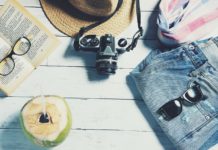In Street Photography we are steadily on the search for scenes that go unnoticed by the normal pedestrian. Funny juxtapositions of persons and their environment are a good start for an interesting photo, but especially when we have two opposed people, there is more to it than only capturing them in the same photo.
The Stereotype
One common scene that is often photographed is a homeless person and a well-dressed person in a suit. These are one of the strongest juxtapositions in photography you can find on the street and while they are emotional, they are very used-up. So in order to create an outstanding image we have to go deeper and not only “catch” two opposing subjects but create a connection between them.

This is one of the older images of mine, that doesn’t work for various reasons, but most prominent for the lack of connection between the persons. There is a little contrast between the white and blue collar worker and what could have lent to an interesting image, didn’t work because they only happen to be random at the same place. The man in the front isn’t noticing the other person in the image and the person in the background is looking somewhere else too. I managed to capture them both, but that was the only “achievement” of mine, there is nothing more to add to this image.
Why Connections are important
Photography is all about telling a story. A plot needs to have a beginning, a middle and an end. Without connections, you have different fragments of various stories that are not related to each other. The subjects are in the same frame, but they take part in different plays. In addition to that, every single subplot doesn’t have the strength to carry a complete story on its own.
If you feel that these parts are strong enough on their own, don’t mix them up with other elements, but rather try to isolate them. This makes it easier to add little details and to focus only on one plot.
Having different elements connected makes it easier to tell a story from beginning to end. This doesn’t mean that there is only one true way of interpreting the picture. How the story evolves is still up to the viewer.
Forms of Interaction
To start things off, I split the interactions into two categories: human to human interaction and the connection between people and their environment.
For the first, there can be the following interactions such as:
- Verbal Communication
- Eye Contact
- Physical contact
- Gestures
- Body Language
All these are forms of communication. In fact, we communicate predominantly non-verbally. So if you are searching for connections between people, try to interpret their facial expression, body language, and general posture.
Connections between human and their environment can be done when they are related in some way. Maybe there is a background that is quite similar to its subjects or the exact opposite?
Examples
The first image displays the connection between people and their background. The similarity between the subjects and the mannequins in the background offers an interesting image. It doesn’t have a deep story but shows, what might go unnoticed by most bypassers.
The quality of the image is totally based on the connection. Take away either the foreground or the background and there wouldn’t anything remarkable or worth photographing.

In the following image, I did put the focus on the human interaction, that is expressed as a triangle between the guy on the left staring at the woman who is whistling and the man in between them. The eye contact and the gesture can be the beginning of an interesting story of human interaction. How exactly you put together the pieces is up to you, but the interaction opens up the story.

It is all about the Emotions
I already emphasized that the emotions in a photograph are a huge part of the quality of pictures. Evoking these feelings on the observer leaves a great impression behind. Photographs can either evoke emotions indirectly through abstract displays that first have to be interpreted by the viewer or simply by displaying emotions. Having interactions between the subjects automatically comes with some sort emotions – some stronger than others – that by photographing the scene can be evoked within the viewer. Connections facilitate these emotions and are therefore an important part of Street Photography.
Stay Curious
Sebastian Jacobitz





















